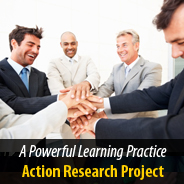Will the development of a Personal Learning Network, coupled with professional development support, increase collaboration among the HRA faculty? Our school needs a way to collaborate and a way to continue professional development. Everyone has many responsibilities; consequently it is difficult to find common time to share with one another. We need a way to share and learn asynchronously. We need a personal learning network.
Objectives and Assessment
School Year 2010-11
To facilitate the development of a personal learning network utilizing two primary sources:
- HRA Learning Together Ning
- Diigo
School Year 2011-12 (beginning with summer 2011)
To provide collaborative opportunities for faculty to learn and demonstrate their understanding and knowledge of 21st century thinking:
- Ongoing Professional Development Workshops beginning Summer 2011 focusing on collaborative tools and resources.
- Participation on the HRA Learning Together Ning.
- Creation and implementation of a “21st-centurized” lesson
Goals and Measurement
Goal #1 -Faculty will be active members of the HRA Learning Together Ning. They will reply to at least one discussion before the end of the year. They will add something to the Ning themselves (post a new discussion, add a video or article, start a group, etc.). Faculty will become comfortable with social bookmarking. They will create a Diigo account and follow the Digital Learning Team.
Measurement – We will document pre and post participation on the HRA Learning Together Ning. Diigo participation will be measured by the Digital Learning Team each of whom will follow all faculty participants.
Goal #2 (Begins Summer 2011) – Internal collaboration among HRA Faculty will increase. Summer professional development opportunities will be developed focusing on collaborative tools and resources.
Measurement -Continue to measure faculty participation in the HRA Learning Together Ning. Ask faculty to document examples of internal collaboration on the HRA Learning Together Ning.
Goal #3 (Begins Summer 2011) – Faculty will become more familiar with web 2.0 applications. Summer professional development offerings will include workshops on web 2.0 tools that enhance collaboration. During the school year 2011-12, monthly professional development offerings will include workshops on tools and resources the Digital Learning Team has examined and found useful. Faculty will have the opportunity to request workshop offerings using the HRA Ning, based on their needs and interests.
Measurement – Pre-implementation survey and post-implementation survey. This will be measured by the success of the “21st-centurized” lesson objective.
Goal #4 (By end of the year 2012) – Each faculty member will work with another faculty member to create and implement a collaborative “21st-centurized” lesson.
Measurement – Flip video cameras will be used to document lessons. Critical Friends rubric will be used to provide feedback to faculty.
Year 1 – How we got to our research and when we implemented our research.
- Sep 2010 to Jan 2011 team members learn about 21st Century learning and develop their own personal learning network
- Jan 2011 begin to develop our project using Google docs and wiki
- Feb 2011 meet f2f to discuss project; PLP team meeting online
- following that meeting, some of us met impromptu and talked about what would most benefit the faculty and how we could do that
- March 2011 f2f meeting to go over the project step by step clarifying objectives, goals
- April 2011 roll out plan at faculty meeting
- by June 2011 faculty will have completed goals with help from digital learning team
- Summer 2011 faculty will continue to collaborate and learn more about developing their network using 21st century learning tools
- by Spring 2012 faculty will have implemented 21st century tools in a lesson plan
One of the issues we discussed in our F2F meeting was the need for positive reinforcement-more than learning something new. We felt we needed recognize the efforts of our peers. To this end, we generated many possibilities. The most brilliant idea was Ningo Bingo. It rewarded our peers for completing the goals and allowed greater growth for those interested. For a bingo, we had little edible treats with kitschy positive affirmations. We sent personal notes to our group members to recognize their efforts and keep them going. For a bingo blackout, the learner earned a gift card (to one of our local businesses. It support our scrip program that helps fund Model U.N.). Also, blackout winners had their card entered into a drawing for an iPad2. Blackout learners also had their name posted on the Ning. We, members of the digital learning team, tried to keep their learning growing by posting new sites that may be useful on Diigo, recommending groups for them to check out, and responding to their posts on the Ning.
We haven’t compiled our statistics yet, however we have some informal results.
Our two requirements were to create a Diigo account, bookmark a site, and follow someone on digital team and to become a member of our HRA Ning, post a response to a discussion, and to start a discussion.
In the first few days, there were 66 new posts/discussions on the ning. Several took additional steps and began RSS feeds and took a look at blogging. Also, many have their Diigo accounts going and some are now bookmarking on Diigo. They are beginning to build their own network.
BEST YET, we are working together. We have collaborated across disciplines, across grade levels, and across age groups. Faculty members that have just learned are teaching others how to create their Diigo account or ning posts. We required faculty to complete the goals. Staff was invited to participate. Staff has participated-eagerly and in droves. It has been inspirational!
We haven’t finished out the first goal for this year; that will occur in June. We are hoping for a runaway success.
We have placed our beginning Google Docs, instructions, revisions, final project, faculty meeting xtranormal presentation, and the Ningo Bingo on
our wik.
HRA Learning Together Ning


